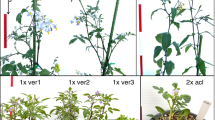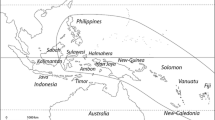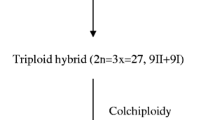Abstract
Specimens in the germplasm collection at the U.S. Vegetable Laboratory, United States Department of Agriculture (USDA) in Charleston, SC, were studied to examine phylogenetic relations of the tetraploid accessions inIpomoea sectionBatatas. This collection contains tetraploidsfrom a wide geographic range and most were tentatively identified by the collector asI. trifida. This study shows that corolla and sepal traits may be used to distinguish the tetraploidsfrom known specimens ofI. trifida (diploid) andI. batatas (hexaploid). All but one tetraploid accession examined (CH67.50) had corolla tubes and sepals shaped likeI. batatas and more closely resembled that species thanI. trifida. Use of corolla tube diameter allowed the hexaploidI. batatas and tetraploid accessions to be distinguished fromI. trifida because the corolla tubes were wider immediately above the calyx. Differences in sepal shape were quantified using the angle at the sepal apex. This angle was consistently obtuse in theI. batatas hexaploids and the tetraploids, but was acute in theI. trifida accessions. Due to similarities in sepal and corolla traits, these tetraploids should be reidentified as tetraploidI. batatas, a cytological race of the hexaploid I. batatas (the sweetpotato).
Zusammenfassung
El banco de germoplasma del Laboratorio Vegetal U.S. del Departamento de Agricultura de los Estados Unidos en Charleston, S.C., en su colección posee especímenes de entradas tetraploides deIpomoea batatas (identificadas comoIpomoea trifida,) con amplia distributión geográfica. El objetivo príncipal del presente estudiofue verificar la relatión filogenética de las entradas tetraploides con especímenes deI. batatas (hexaploide) eIpomoea trifida (diploide). Las características relacionadas a la forma y tamaño del corola y los sepalos fueron considerados para diferenciar tetraploides, diploides, y hexaploides. La forma del sepalo y tubo de la corola de la mayoría de tetraploides, excepto la entrada CH67.50, poseen estrecha similitud con la batata cultivada diferenciandosé deIpomoea trifida. Para cuantificar las diferencias en el tamaño de corola fue considerado el diámetro del tubo. Así, la batata cultivada y las entradas tetraploides se diferencian deI. trifida debido al ensanchamiento del tubo de la corola sobre el cáliz. Asímismo, para cuantificar las diferencias en la forma de sepalo fue considerado la forma del ápice. La batata cultivada y las entradas tetraploides poseen forma considerablemente obtusa mientras queI. trifida posee forma aguda. Debido a las similitudes entre tetraploides y hexaploides en la forma y tamaño de sepalo y corola, los tetraploides serían re-identificados como I. batatas tetraploide, considerandosé como una raza citológica de la batata cultivada.
Similar content being viewed by others
Literature Cited
Austin, D. F. 1975. Convolvulaceae.In Flora of Panama. Annals of the Missouri Botanical Garden 62: 157–224.
—. 1977. Hybrid polyploids inIpomoea sectionBatatas. Journal of Heredity 68:259–260.
—. 1978. TheIpomoea batatas complex-Taxonomy. Bulletin of the Torrey Botanical Club 105: 114–129.
—. 1980. Convolvulaceae. Pages 288–363in F. M. Dassenayake and F. R. Fosberg, eds., A revised handbook of the flora of Ceylon. Amerind Publ. Co., New Delhi.
—. 1982a. Convolvulaceae. Pages 15-226in Z. Luces de Febres and J. A. Steyermark, eds., Flora de Venezuela. Vol. 8, pt. 3. Instituto Nacional de Parques, Ediciones Fundación Educatión Ambiental, Caracas.
—. 1982b. Convolvulaceae. Pages 1161–1190 in D. S. Correll and H. B. Correll, eds., Flora of the Bahama Archipelago. J. Cramer, Vaduz.
—. 1982c. Convolvulaceae. Pages 1–99in G. Harling and B. Sparre, eds., Flora of Ecuador, No. 15. Swedish Research Councils, Stockholm.
—. 1985. Variation and evolution as factors in sweet potato origins. Report to Food and Agriculture Organization of the United Nations/International Board of Plant Genetic Resources (IBPGR), Rome.
—. 1990. Convolvulaceae. Pages 548–583in W. L. Wagner, D. R. Herbst, and S. H. Sohmer, eds., Manual of the flowering plants of Hawai’i. Univ. Hawaii Press and Bishop Museum Press, Honolulu.
—. 1991.Ipomoea littoralis (Convolvulaceae): Taxonomy, distribution and ethnobotany. Economic Botany 45:251–256.
-,R. Jarret, and R. W. Johnson. 1993.Ipomoea gracilis R. Brown (Convolvulaceae) and its allies. Bulletin of the Torrey Botanical Club 120 (in press).
Brown, A. H. D., O. H. Frankel, D. R. Marshall, and J.T. Williams, eds. 1989. The use of plant genetic resources. Cambridge Univ. Press, Cambridge.
Choisy, J. D. 1834. Convolvulaceae Orientales. Mémoirs de la société de physique et d’histoire naturelle de Genève 6:385–502, pl. 1–7.
—. 1838. De Convolvulaceis Dissertatio Secunda. Mémoirs de la société de physique et d’histoire naturelle de Genéve 8:121–164, pl. I-IV.
—. 1845. Convolvulaceae. Pages 323–465in DeCandolle, A., ed., Prodromus, 9. Geneva.
Díaz, J., F. de la Puente, and D. F. Austin. 1992. Enlargement of fibrous roots inIpomoea sectionBatatas (Convolvulaceae). Economic Botany 46:322–329.
Freyre, R. M., M. Iwanaga, and G. Orjeda. 1991. Useof Ipomoea trifida (H.B.K.) G. Don germ plasm for sweet potato improvement. 2. Fertility of synthetic hexaploids and triploids with 2n gametes ofI.trifida, and their interspecific crossability with sweet potato. Genome 34:209–214.
Hallier, H. 1893. Versuch einer natürlichen Gliederung der Convolvulaceen auf morphologischer und anatomischer Grundlage. Botanisches Jahrbuch für Systematik 16:453–591.
House, H. D. 1908. The North American species of the genusIpomoea. Annals of the New York Academy of Sciences 18:181–263.
Iwanaga, M., R. Freyre, and G. Orjeda. 1991. Use ofIpomoea trifida (H.B.K.) G. Don germ plasm for sweet potato improvement. 1. Development of synthetic hexaploids ofI.trifida by ploidy-level manipulations. Genome 34:204–208.
Jarret, R., A. Whittemore and N. Gawel. 1992. Phylogenetic relationships of sweetpotato (Ipomoea batatas (L.) Lam.). Journal of the American Society of Horicultural Sciences 117:633–637.
Jones, A. 1970. Asynapsis inIpomoea gracilis. Journal of Heredity 61:151–152.
—. 1990. Unreduced pollen in a wild tetraploid relative of sweetpotato. Journal of the American Society of Horticultural Sciences 115:512–516.
—,P. D. Dukes, and J. M. Schalk. 1986. Sweet potato breeding. Pages 1–35in M. Basset, ed., Breeding vegetable crops. AVI Publishing Co., Westport, CT.
Martin, F. W., and A. Jones. 1972. The species ofIpomoea closely related to the sweet potato. Economic Botany 26:201–215.
—,A. Jones, and R. M. Ruberte. 1974. A wildIpomoea species closely related to the sweet potato. Economic Botany 28:287–292.
McDonald, J. A., and D. F. Austin. 1990. Additions and changes inIpomoea sectionBatatas (Convolvulaceae). Brittonia 42:116–120.
Meeuse, A. D. J. 1957. The South African Convolvulaceae. Bothalia 6:641–792.
Meisner, C. F. 1869. Convolvulaceae. Pages 200–424in C. von Martius, ed., Flora Brasiliensis, 7.
Mayr, E., and P. D. Ashlock. 1991. Principles of systematic zoology. McGraw-Hill, Inc., New York.
Nishiyama, I., H. Fujise, T. Teramura, and T. Mayazaki. 1961. Studies of sweet potato and its related species. I. Comparative investigations of the chromosome numbers and main characters ofIpomoea species in sectionBatatas. Japanese Journal of Breeding 11:37–43.
—,and T. Teramura. 1962. Mexican wild forms of sweet potato. Economic Botany 16:304–314.
Oration, M. Z., K. Niwa, and I. Shiotani. 1990. Cytological analysis of tetraploid hybrids between sweet potato and diploidIpomoea trifida (H.B.K.) Don. Theoretical and Applied Genetics 80:617–624.
Orjeda, G., R. Freyre, and M. Iwanaga. 1990. Production of 2n pollen in diploidIpomoea trifida, a putative wild ancestor of sweet potato. Journal of Heredity 81:462–467.
SAS Institute. 1988. SAS/STAT user’s guide release 6.03 edition. SAS Institute Inc., Cary, NC.
Shiotani, I., and T. Kawase. 1987. Synthetic hexaploids derived from wild species related to sweet potato. Japanese Journal of Breeding 37:367–376.
—,and —. 1989. Genomic structure of the sweet potato and hexaploids ofIpomoea trifida (H.B.K.) Don. Japanese Journal of Breeding 39:57–66.
—,S. Yoshida, and T. Kawase. 1990. Numerical taxonomic analysis and crossability of diploidIpomoea species related to the sweet potato. Japanese Journal of Breeding 40:159–174.
Ting, Y. C., A. E. Kehr, and J. C. Miller. 1957. A cytological study of the sweet potato plantIpomoea batatas (L.) Lam. and its related species. American Naturalist 91:197–203.
Verdcourt, B. 1963. Convolvulaceae. Pages 1–161in C. E. Hubbard and E. Milne-Redhead, eds., Flora of tropical East Africa. Crown Agents for Oversea Governments and Administrations, London.
Wedderburn, M. M. 1967. A study of hybridization involving the sweet potato and related species. Euphytica 16:69–75.
Williams, D. B., and F. W. Cope. 1967. Notes on self-incompatibility in the genusIpomoea L. Pages 16–30in E. A. Tai, W. B. Charles, E. F. Iton, B. H. Haynes, and K. A. Leslie, eds., Proceedings of the International Symposium on Tropical Roots Crops. Vol. 1. Univ. West Indies, Trinidad.
Yen, D. E. 1974. The sweet potato and Oceania. Bishop Museum Press, Honolulu.
Author information
Authors and Affiliations
Rights and permissions
About this article
Cite this article
Bohac, J.R., Austin, D.F. & Jones, A. Discovery of wild tetraploid sweetpotatoes. Econ Bot 47, 193–201 (1993). https://doi.org/10.1007/BF02862022
Received:
Accepted:
Issue Date:
DOI: https://doi.org/10.1007/BF02862022




